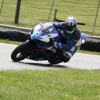Based on the information given, I'd imagine that the .380 was a small sized pistol, where the larger caliber weapons were in larger platforms and therefore better at absorbing recoil. Yes, larger caliber weapons will do more damage, but at the cost of more recoil and lower ammunition capacity. The damage done with a smaller round will be less, but it still can be stopping if put in the right place. Any round will have at least a somewhat rounded nose, which can deflect if it hits at the right angle. It has happened with small and large calibers. If someone is given a shoulder fired weapon with a long sight radius of course they will shoot better than with a pistol. A .410ga will do more damage than a pistol round, but it also has a much shorter effective range. A .410 also requires a heavier weapon to manage the recoil. If you give me a weapon and tell me to do something or you're going to punch me in the face, I'm going to shoot you. The fact that people were off paper means that they need way more practice. They should not have been qualified to carry that weapon. Kevlar vests are designed to stop pistol rounds. They will usually stop up to a .45ACP. A shot shell will not penetrate, and the spread will impart less energy into one location on the target. A slug will penetrate. The energy is still absorbed by the body, the vest just prevents penetration. A vest will save your life if your hit, but the impact puts you down hard. Two shots in the same place will penetrate. Plates will usually offer protection up to 7.62mm, but they are also used up after they are hit. The round still imparts enough force to put you on your ass as well. If your target is wearing a vest, unless you are in a combat zone, you're in the wrong place.


